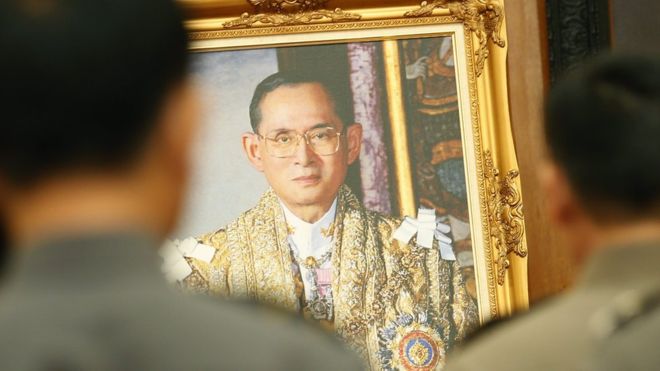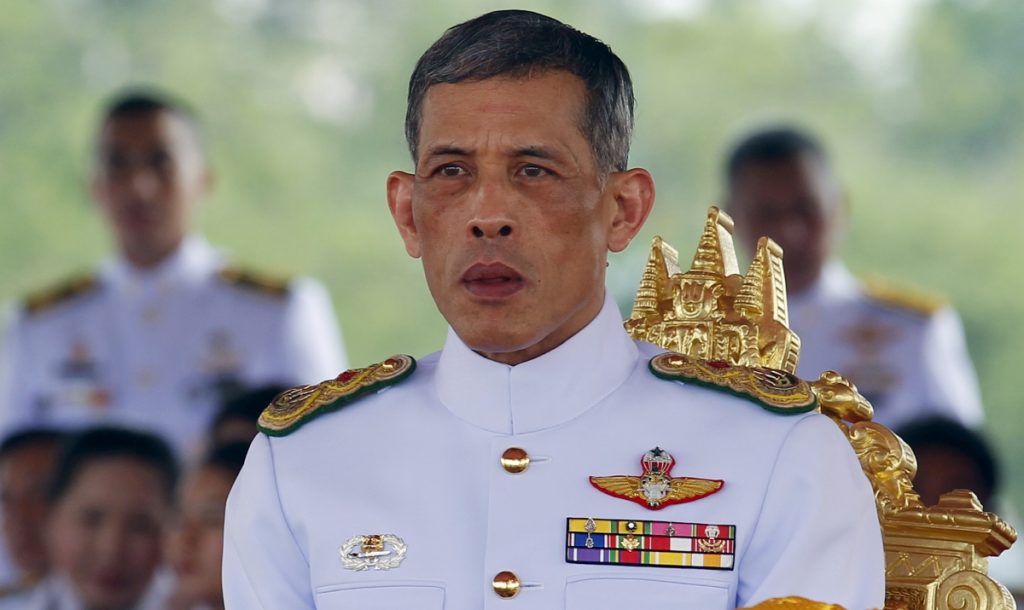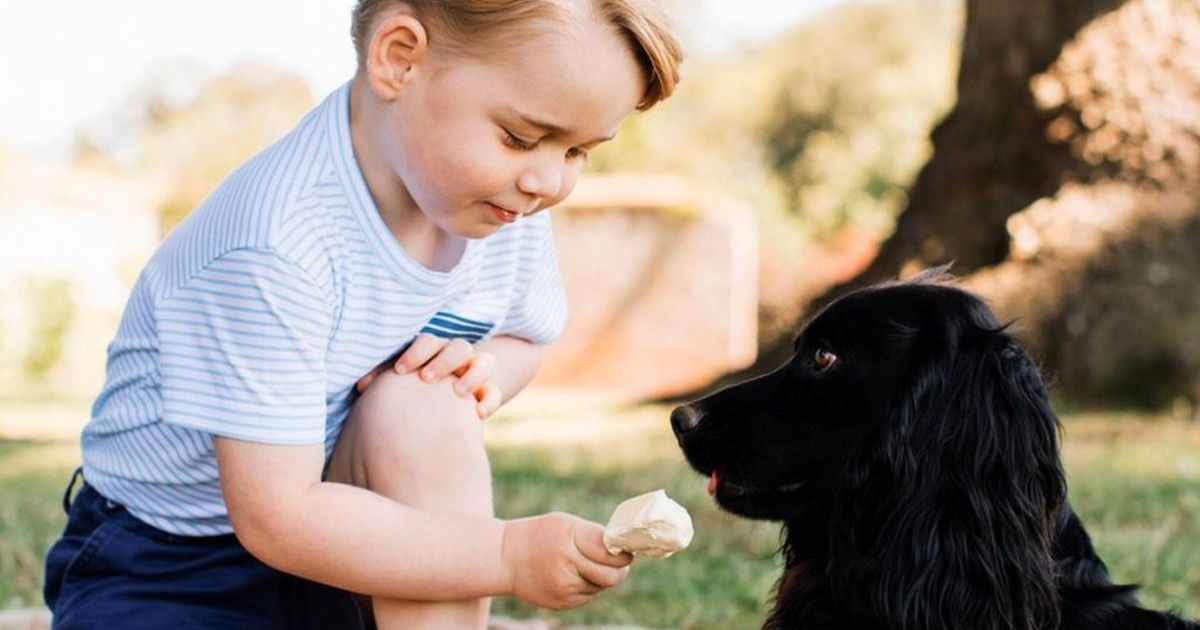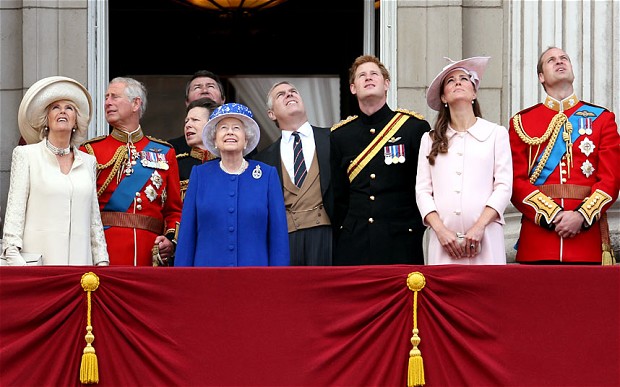How tattoos and a crop top may signal the end of the Thai monarchy’s public and private divide and the sacredness of royal bodies.
In late July, two royal families had an issue with information management.
In Britain, the Duke and Duchess of Cambridge were widely criticised for a picture they released to the public. The picture, showing a young Prince George feeding his pet dog a white chocolate ice cream, sparked online outrage. A furious Twitter user reportedly called the three-year-old a ‘monarchist monster’. Another suggested that young George should be sent to prison for the misdemeanour.
During the same week, another royal violation unraveled on a Munich runway, when the Crown Prince of Thailand was captured in some exceptionally strange gear. A unisex crop top and low-hanging jeans highlighted garish tattoos covering his front, back and arms. While these may be stickers rather than genuine tattoos, the image is now firmly imprinted on the minds of all who saw it.
In the latter case it was the controversial German tabloid Bild that released the images and the photos went viral when journalist and author Andrew MacGregor Marshall posted them on Facebook.
Both events illustrate a problem common for modern monarchies.
Social media has transformed the way societies consume information. As with previous media revolutions, monarchies have no choice but to engage in the new information environment. Just as TV did before, and the photographic revolution before that, the Internet facilitates public access into a supposedly private sphere. Just as ‘we,’ the general public, have been forced to relinquish some portion of our own private lives in order to participate in this latest communications revolution, so must the royal ‘we’ adapt and adjust.
What images does a monarch post on Facebook if it is not a glittering expression of formal royal duty – the king or queen in ritual context — or an image like that of Prince George that purports to offer some kind of humanising insight into Britain’s future King?
Obviously, there are potentially radical and upsetting implications for providing this level of intrusion into the private world of public figures, and royalty understand these implications well. Such photographic ‘insights’ have to be stage-managed more carefully than ever to protect the public role of the monarch.
As has been argued of the British monarchy, where one may argue such things, it has long been imperative to maintain the queen’s ‘two bodies’; a ‘body public’ that projects the symbolic aura of the Sovereign, and a private ‘body natural’ that is all too human.
As Ilse Hayden states, ‘much of the appeal of the Queen as symbol derives from her personhood, but the messiness of being a person must not be allowed to intrude upon the dignity of the institution of Queenship.’
In the case of young George, feeding chocolate to the dog was messy, and someone should have surely stopped the royal ‘we’ from making the slip-up.
For the Crown Prince of Thailand, however, this went well beyond a mere slip to near self-sabotage. Why did he do it? Was there not some sort of mechanism to stop him from stepping onto that runway?
The answer requires some thought concerning the nature of the two royal bodies, first generally, and then in a Thai context.
The nature of royal bodies
Firstly, the maintenance of the two bodies, public and private, is not trivial, a mere practical issue concerning management of a ‘surface image’ or ‘representation.’ It is a critical and substantive part of being a monarch – perhaps the essence of monarchy.
In Britain, the concept and management of the sovereign’s ‘two bodies’ evolved over many centuries. In an era in which the monarch actually governed, the ‘body natural’, which was an actual legal status, was a way of dealing with the political ramifications of power. It was a means of explaining the fallibility of the monarch when he made bad decisions, while protecting the sacred legitimacy granted upon the king by God. This became a critical distinction, particularly from the time the English started to execute or depose their kings.
Even today, when the Queen is resident in Buckingham Palace, she will meet with the Prime Minister on a weekly basis. Discussions are conducted in private, and what is said remains concealed from public knowledge. While it is widely believed the Queen does not have political influence, the taboo is such that we, her subjects, cannot know for sure. Therein lies the essence of her majesty and her power, and the crux of the relationship between sovereign and state.
Over time, the idea of the monarch’s ‘body natural’ may have become less important as a legal instrument, but it continued to serve an important purpose.
The industrial, political and social transformations of the 19th century in Britain saw a dramatic decrease in the monarch’s power. As a result, those around the throne were forced to work harder than ever to sacralise the monarchy through a claim to historic legitimacy.
During the latter half of the century in particular, ceremonies were created and recreated, discreet historical fragments captured and reworked, in order to associate the contemporary monarchy with a deep “national” past. No longer imbued with a God-given legitimacy, royals had to work extra hard to insure their public lives conformed to the mythology constructed around them.
Yet, their new balancing act came with significant rewards.
Unproductive inherited wealth and great landed estates ran counter to new rules of moneymaking, and therefore needed to be defended. To counter the claim that the monarch’s wealth was illegitimate, therefore, the grand displays of historic pageantry were combined with faux insights into the monarch’s ‘private’ life.
Emphasising an austere frugality, as well as a deep commitment to bourgeois notions of the family, such insights helped to deflect criticism of the monarch’s wealth, portraying it as a mere characteristic of what was, nevertheless, the natural state of national affairs. While giving little away about what really went on behind closed doors, such ‘faux’ insights became crucial to protecting and legitimising the wealth of the monarch in the eyes of the general population. To delve into the wealth of the monarch was to insult the dignity of the throne.
Throughout the 20th century, the British monarchy has continued to help secure public support and even nostalgia for the aristocracy, in part by implanting and advancing the idea that protection of an old and privileged elite runs counter to crass and more predatory forms of modern capitalism.
As popular TV programs like Downton Abbey illustrate so well, the aristocracy continues to be presented to the general public as the morally virtuous face of inequality. The hidden backdrop to such scenarios remains the historic legitimacy provided to that class by a deeply rooted and ‘archaic’ monarchy.
Thai royal bodies
In Thailand, the arrival of related notions of modern monarchy and the balancing act therein came much later, under conditions of force. Siamese kings and their courtiers had a far shorter period of time in which to adapt deeply ingrained regional traditions based on concepts and images of the Hindu god-king and the Buddhist Dhammaraja to Westernised forms that could better cope with the onset of capitalism.
While one can debate the exact dates, it can be justifiably argued that the modern dynamic of ‘public body’ and ‘body natural’ only came to truly define the life of the Siamese monarch in the early 20th century, when criticism of royal privilege began seriously to mount within an emergent public sphere, from competitors who were not princes.
As Matthew Copeland and Scot Barme have shown, during the 1920s, cartoons widely disseminated via print media explicitly depicted what an unpopular monarch and his inner circle were believed to be up to in private, and it was not pretty. Dominant themes were greed and sexual promiscuity.
While Ramas VI and VII, unpopular and uncharismatic sons of Chulalongkorn the Great, continued to launch grand historic and modernising spectacles in the Siamese and European fashion, they were unable to escape now dominant narratives portraying such displays as ‘excessive,’ ‘backwards’ and a ‘waste’ of time and money — all signs of a moribund regime.
The revolution of 1932 transformed the so-called “absolute monarchy” into an equally so-called “constitutional monarchy.” More importantly, and most galling to top Siamese royalty, Crown lands and treasure began to fall under control of a civilian and later military-led government.
As noted in Judith Stowe’s Siam becomes Thailand, such efforts, along with equally spirited attempts to confiscate the ‘private’ wealth of the monarch, were devastating not only to the institution itself, but to all of those connected to it. As the private palaces of top royals were turned into government ministries, the ‘public body’ of the monarch became largely defunct.
In the post-World War II era, in ways that remain as private as Queen Elizabeth’s meetings with her prime ministers, ambitious royals managed to return many of these assets to the royal household. When King Bhumibol arrived in Bangkok in 1950, ready to reign, the royal family was thus once again provided with private space within which to function. While this was vital to resurrecting royal power, it did not provide the monarch with the immense wealth necessary to resurrect his ‘public body’. To do that, King Bhumibol and his wife, Queen Sirikit, had to secure the financial future of the institution, meaning they had to embrace capitalism.
As Thak Chaloermtiarana and Paul Handley have shown, the Phibun government of the 1950s severely limited the king’s public appearances, fearful that the a young king’s developing barami or ‘virtue’ might overshadow his own.
As a result, expansion of the royal finances was dependent upon shoring up alliances with existing nobility and their business and banking connections, and actively engaging with newer money monopolised by the elite of a burgeoning urban Chinese-Thai community. Thus, through innumerable, discreet partnerships and alliances forged by the king and his courtiers in a mostly private capacity, the Crown Property Bureau was transformed into a modern and model capitalist enterprise.
When the state wholeheartedly embraced monarchy in 1958, the royal couple was welcomed onto a national stage. There they could resurrect the spectacles and ceremonies of the past for a modern national and international community. Now, however, the monarchy benefitted a far broader catchment of vested interests than the nobility alone.
With state ideology dominated by a developmentalist agenda that embraced national security and a commitment to American-led capitalism above all else, the monarch’s ‘public body,’ increasingly presented a worldview in stark contrast to the modern, consumerist urban society to which he belonged.
 By presenting a public and sincere face of loving kindness towards crowds of adoring rural farmers, the monarch, usually dressed in modest, ordinary garb, thus protected himself from the burgeoning business portfolio of the Crown Property Bureau. In doing so he successfully separated private commercial activity from the glittering, celestial imagery of his ‘public body’.
By presenting a public and sincere face of loving kindness towards crowds of adoring rural farmers, the monarch, usually dressed in modest, ordinary garb, thus protected himself from the burgeoning business portfolio of the Crown Property Bureau. In doing so he successfully separated private commercial activity from the glittering, celestial imagery of his ‘public body’.
Carefully select ‘glimpses’ into his private life and that of his family were now carefully crafted to ensure that they confirmed the monarch’s virtues of love, frugality and modesty.
After the devastation of the Asian Financial Crisis of the late 1990s, the Crown Property Bureau was forced to intensify its activities. The now aging monarch, through an army of surrogates known as the ‘network monarchy’, ramped up production of an ideology promoting a retreat from the excesses of capitalism, the so-called ‘sufficiency economy.’
Thus he was forced to work even more tirelessly to cultivate the image of a frugal and moderate individual totally detached from, and indifferent to, the now even more fabulous benefits of Crown business deals.
This, too, must have taken some effort, requiring the focused determination by those around him to carefully stage-manage any insight into his private life.
A royal body in a crop top
The image of the Crown Prince on the Munich runway represents a near catastrophic collapse of the genuinely private into public. In the modern information age, it is to be expected, indeed inevitable, that the royal ‘we’ occasionally reveals a bit too much. That does not make it any less damaging, however. Rather, it is now more imperative than ever for monarchies to run a tight ship.
This is dependent, of course, on whether individual royals want to play along.
In the aftermath of the runway incident, some questioned whether the lapse was intentional. If true, that raises the even more tantalising possibility that while vested interests in Thailand desperately need royals to maintain proper distinctions of public and private, the monarchy may have begun to decouple from this historic role altogether.
Dr Matthew Phillips is based in the Department of History & Welsh History at Aberystwyth University.
 Facebook
Facebook  Twitter
Twitter  Soundcloud
Soundcloud  Youtube
Youtube  Rss
Rss 

